Activation of Persulfate by NiFe-Layered Double Hydroxides Toward Efficient Degradation of Doxycycline in Water
Abstract
:1. Introduction
2. Results and Discussion
2.1. X-Ray Diffraction Analysis
2.2. Evaluation of Catalyst Performance
2.3. Intermediate Products and Toxicity Prediction
3. Materials and Methods
3.1. Chemicals and Devices
3.2. Preparation of NiFe-Layered Double Hydroxides
3.3. Characterization
3.4. Degradation Experiments
4. Conclusions
Author Contributions
Funding
Data Availability Statement
Conflicts of Interest
References
- Bungau, S.; Tit, D.M.; Behl, T.; Aleya, L.; Zaha, D.C. Aspects of Excessive Antibiotic Consumption and Environmental Influences Correlated with the Occurrence of Resistance to Antimicrobial Agents. Curr. Opin. Environ. Sci. Health 2021, 19, 100224. [Google Scholar] [CrossRef]
- Ali, A.E.; Elasala, G.S.; Atta, R.M.; Kolkaila, S.A. Synthesis, Thermal Analysis and Characterization of Doxycycline Metal Complexes. Chem. Res. J. 2022, 7, 90–99. [Google Scholar]
- Kumar, K.; Gupta, S.C.; Chander, Y.; Singh, A.K. Antibiotic Use in Agriculture and Its Impact on the Terrestrial Environment’. Adv. Agron. 2005, 87, 1–54. [Google Scholar] [CrossRef]
- Zhang, L.; Jiang, S.; Jia, Y.; Zhang, M.; Guo, J. Effects of Na+/H2O2 on Nitrogen Removal and Sludge Activity: Performance and Mechanism. J. Environ. Chem. Eng. 2024, 12, 113194. [Google Scholar] [CrossRef]
- Xu, D.; Wu, S.; Yan, A.; Chen, Z.; Xu, J.; Gu, C.; Qi, Y.; Wu, S. Efficient Recycling of Sewage Water in a Polyester Integrated Industry: A Case Study. Desalination Water Treat. 2024, 319, 100508. [Google Scholar] [CrossRef]
- Abbas, A.; Barkhouse, A.; Hackenberger, D.; Wright, G.D. Antibiotic Resistance: A Key Microbial Survival Mechanism That Threatens Public Health. Cell Host Microbe 2024, 32, 837–851. [Google Scholar] [CrossRef]
- Ferro, G.; Guarino, F.; Castiglione, S.; Rizzo, L. Antibiotic Resistance Spread Potential in Urban Wastewater Effluents Disinfected by UV/H2O2 Process. Sci. Total. Environ. 2016, 560–561, 29–35. [Google Scholar] [CrossRef]
- Jiang, L.; Hu, X.; Yin, D.; Zhang, H.; Yu, Z. Occurrence, Distribution and Seasonal Variation of Antibiotics in the Huangpu River, Shanghai, China. Chemosphere 2011, 82, 822–828. [Google Scholar] [CrossRef] [PubMed]
- Chang, X.; Meyer, M.T.; Liu, X.; Zhao, Q.; Chen, H.; Chen, J.-A.; Qiu, Z.; Yang, L.; Cao, J.; Shu, W. Determination of Antibiotics in Sewage from Hospitals, Nursery and Slaughter House, Wastewater Treatment Plant and Source Water in Chongqing Region of Three Gorge Reservoir in China. Environ. Pollut. 2010, 158, 1444–1450. [Google Scholar] [CrossRef]
- Zuccato, E.; Castiglioni, S.; Fanelli, R. Identification of the Pharmaceuticals for Human Use Contaminating the Italian Aquatic Environment. J. Hazard. Mater. 2005, 122, 205–209. [Google Scholar] [CrossRef]
- Holmes, N.E.; Charles, P.G. Safety and Efficacy Review of Doxycycline. Clin. Med. Ther. 2009, 1, CMT.S2035. [Google Scholar] [CrossRef]
- Honarmandrad, Z.; Sun, X.; Wang, Z.; Naushad, M.; Boczkaj, G. Activated Persulfate and Peroxymonosulfate Based Advanced Oxidation Processes (AOPs) for Antibiotics Degradation—A Review. Water Resour. Ind. 2023, 29, 100194. [Google Scholar] [CrossRef]
- Yang, Q.; Jia, N.; Shen, C.; Ma, J.; Wen, Y. Activation of Peroxymonosulfate by Fe-N Complexes Embedded within SBA-15 for Removal of Organic Contaminants via Production of Singlet Oxygen. Environ. Sci. Pollut. Res. 2018, 25, 34190–34199. [Google Scholar] [CrossRef]
- Lutze, H.V.; Bircher, S.; Rapp, I.; Kerlin, N.; Bakkour, R.; Geisler, M.; von Sonntag, C.; Schmidt, T.C. Degradation of Chlorotriazine Pesticides by Sulfate Radicals and the Influence of Organic Matter. Environ. Sci. Technol. 2015, 49, 1673–1680. [Google Scholar] [CrossRef]
- Monahan, C.; Nag, R.; Morris, D.; Cummins, E. Antibiotic Residues in the Aquatic Environment—Current Perspective and Risk Considerations. J. Environ. Sci. Health Part A 2021, 56, 733–751. [Google Scholar] [CrossRef]
- Matzek, L.W.; Carter, K.E. Activated Persulfate for Organic Chemical Degradation: A Review. Chemosphere 2016, 151, 178–188. [Google Scholar] [CrossRef]
- Huang, K.-C.; Zhao, Z.; Hoag, G.E.; Dahmani, A.; Block, P.A. Degradation of Volatile Organic Compounds with Thermally Activated Persulfate Oxidation. Chemosphere 2005, 61, 551–560. [Google Scholar] [CrossRef] [PubMed]
- An, D.; Westerhoff, P.; Zheng, M.; Wu, M.; Yang, Y.; Chiu, C.-A. UV-Activated Persulfate Oxidation and Regeneration of NOM-Saturated Granular Activated Carbon. Water Res. 2015, 73, 304–310. [Google Scholar] [CrossRef]
- Du, X.; Zhang, Y.; Hussain, I.; Huang, S.; Huang, W. Insight into Reactive Oxygen Species in Persulfate Activation with Copper Oxide: Activated Persulfate and Trace Radicals. Chem. Eng. J. 2017, 313, 1023–1032. [Google Scholar] [CrossRef]
- Liu, D.; Guo, A.; Qi, Y.; Ji, Z.; Li, H.; Cao, X.; Zhang, Z.; Zhang, X.; Wu, K.; Cai, A. Activation of Persulfate by Magnetic Mg/Mn–Layered Double Oxide–Doped Biochar Composite for Ciprofloxacin Removal and Bacterial Inactivation. Sep. Purif. Technol. 2024, 329, 125322. [Google Scholar] [CrossRef]
- Wang, C.; Cao, T.; Lv, Z.; Peng, R.; Mao, Y.; Zhang, J.; Zhu, X.; Wang, J.; Zhao, K.; Song, G. Fabrication of Ce-Doped Macroporous Carbon Fibers for Efficient Degradation of Tetracycline by Activating Persulfate☆. J. Rare Earths 2024, in press. [Google Scholar] [CrossRef]
- Wu, Z.; Tong, Z.; Xie, Y.; Sun, H.; Gong, X.; Qin, P.; Liang, Y.; Yuan, X.; Zou, D.; Jiang, L. Efficient Degradation of Tetracycline by Persulfate Activation with Fe, Co and O Co-doped g-C3N4: Performance, Mechanism and Toxicity. Chem. Eng. J. 2022, 434, 134732. [Google Scholar] [CrossRef]
- Yakamercan, E.; Aygün, A.; Simsek, H. Antibiotic Ciprofloxacin Removal from Aqueous Solutions by Electrochemically Activated Persulfate Process: Optimization, Degradation Pathways, and Toxicology Assessment. J. Environ. Sci. 2024, 143, 85–98. [Google Scholar] [CrossRef] [PubMed]
- Zaheer, Z.; Al-Balawi, A.M.; Kosa, S.A. Ag0, Re0, and Ag@Re Heterogeneous Persulfate Activators for Reactive Radical Based Oxidation of Water Contaminant. J. Mol. Struct. 2024, 1319, 139321. [Google Scholar] [CrossRef]
- Eghbali, P.; Hassani, A.; Wacławek, S.; Lin, K.-Y.A.; Sayyar, Z.; Ghanbari, F. Recent Advances in Design and Engineering of MXene-Based Catalysts for Photocatalysis and Persulfate-Based Advanced Oxidation Processes: A State-of-the-Art Review. Chem. Eng. J. 2024, 480, 147920. [Google Scholar] [CrossRef]
- Xu, Q.; Liu, Y.; Wang, Y.; Song, Y.; Zhao, C.; Han, L. Synergistic Oxidation-Filtration Process of Electroactive Peroxydisulfate with a Cathodic Composite CNT-PPy/PVDF Ultrafiltration Membrane. Water Res. 2022, 210, 117971. [Google Scholar] [CrossRef]
- Liu, J.; Yu, L.; Zhang, Y. Fabrication and Characterization of Positively Charged Hybrid Ultrafiltration and Nanofiltration Membranes via the In-Situ Exfoliation of Mg/Al Hydrotalcite. Desalination 2014, 335, 78–866. [Google Scholar] [CrossRef]
- Yan, K.; Xie, X.; Li, J.; Wang, X.; Wang, Z. Preparation, Characterization, and Catalytical Application of MgCoAl-Hydrotalcite-Like Compounds. J. Nat. Gas Chem. 2007, 16, 371–376. [Google Scholar] [CrossRef]
- Drzewicz, P.; Perez-Estrada, L.; Alpatova, A.; Martin, J.W.; Gamal El-Din, M. Impact of Peroxydisulfate in the Presence of Zero Valent Iron on the Oxidation of Cyclohexanoic Acid and Naphthenic Acids from Oil Sands Process-Affected Water. Environ. Sci. Technol. 2012, 46, 8984–8991. [Google Scholar] [CrossRef]
- Zhou, L.; Zhang, T.; Tao, Z.; Chen, J. Ni Nanoparticles Supported on Carbon as Efficient Catalysts for the Hydrolysis of Ammonia Borane. Nano Res. 2014, 7, 774–781. [Google Scholar] [CrossRef]
- Azqhandi, M.H.A.; Foroughi, M.; Gholami, Z. Efficient removal of levofloxacin by a magnetic NiFe-LDH/N-MWCNTs nanocomposite: Characterization, response surface methodology, and mechanism. Environ. Res. 2022, 215, 113967. [Google Scholar] [CrossRef]
- Zheng, Z.; Wu, D.; Chen, G.; Zhang, N.; Wan, H.; Liu, X.; Ma, R. Microcrystallization and lattice contraction of NiFe LDHs for enhancing water electrocatalytic oxidation. Carbon Energy 2022, 4, 901–913. [Google Scholar] [CrossRef]
- Shi, Q.; Lu, R.; Lu, L.; Fu, X.; Zhao, D. Efficient Reduction of Nitroarenes over Nickel-Iron Mixed Oxide Catalyst Prepared from a Nickel-Iron Hydrotalcite Precursor. Adv. Synth. Catal. 2007, 349, 1877–1881. [Google Scholar] [CrossRef]
- Zhang, C.; Liang, X.; Lu, Y.; Li, H.; Xu, X. Performance of CuAl-LDH/Gr Nanocomposite-Based Electrochemical Sensor with Regard to Trace Glyphosate Detection in Water. Sensors 2020, 20, 4146. [Google Scholar] [CrossRef]
- Luo, X.; Asefa, T.; Qiu, R.; Su, C.; Cui, L.; Huang, Z. Robust Adsorption and Persulfate-Based Degradation of Doxycycline by Oxygen Vacancy-Rich Copper-Iron Oxides Prepared through a Mechanochemical Route. ACS ES&T Water 2022, 2, 1031–1045. [Google Scholar] [CrossRef]
- Ghanbari, F.; Martínez-Huitle, C.A. Electrochemical Advanced Oxidation Processes Coupled with Peroxymonosulfate for the Treatment of Real Washing Machine Effluent: A Comparative Study. J. Electroanal. Chem. 2019, 847, 113182. [Google Scholar] [CrossRef]
- Xie, P.; Ma, J.; Liu, W.; Zou, J.; Yue, S.; Li, X.; Wiesner, M.R.; Fang, J. Removal of 2-MIB and Geosmin Using UV/Persulfate: Contributions of Hydroxyl and Sulfate Radicals. Water Res. 2015, 69, 223–233. [Google Scholar] [CrossRef]
- Ma, R.; Yan, X.; Mi, X.; Wu, Y.; Qian, J.; Zhang, Q.; Chen, G.-H. Enhanced Catalytic Degradation of Aqueous Doxycycline (DOX) in Mg-Fe-LDH@biochar Composite-Activated Peroxymonosulfate System: Performances, Degradation Pathways, Mechanisms and Environmental Implications. Chem. Eng. J. 2021, 425, 131457. [Google Scholar] [CrossRef]
- Xu, H.; Zhang, T.; Wang, D.; Cai, D.; Chen, S.; Wang, H.; Shu, S.; Zhu, Y. Degradation of Tetracycline Using Persulfate Activated by a Honeycomb Structured S-Doped g-C3N4/Biochar under Visible Light. Sep. Purif. Technol. 2022, 300, 121833. [Google Scholar] [CrossRef]
- Guo, Y.; Zhao, L.; Fang, J.; Liu, X.; Qi, J.; Li, H. Tetracycline Degradation by Activated Persulfate with Enhancement of ZIF-67 Loaded Wood-Microreactor. J. Environ. Chem. Eng. 2024, 12, 111901. [Google Scholar] [CrossRef]
- Salama, E.; Mensah, K.; ElKady, M.; Shokry, H.; Samy, M. Effective Degradation of Tetracycline via Persulfate Activation Using Silica-Supported Zero-Valent Iron: Process Optimization, Mechanism, Degradation Pathways and Water Matrices. Environ. Sci. Pollut. Res. 2023, 30, 87449–87464. [Google Scholar] [CrossRef]
- Chen, H.; Meng, F.; Feng, X.; Zhao, Y.; Xie, T.; Wang, D.; Lin, Y. Efficient Photocatalytic Activation of Peroxymonosulfate by Cobalt-Doped Oxygen-Vacancies-Rich BiVO4 for Rapid Tetracycline Degradation. Langmuir 2024, 40, 12778–12791. [Google Scholar] [CrossRef] [PubMed]
- Lin, X.; Chen, F.; Tang, Y.; Hao, C. Tetracycline Degradation by Persulfate Activated with Novel Magnetic Composite Ferrocene/chitosan@Fe3O4. J. Chem. Technol. Biotechnol. 2022, 97, 2766–2774. [Google Scholar]
- Sarkar, P.; Neogi, S.; De, S. Activation of Peroxymonosulfate by S-Scheme Bi2S3/Doped gCN Heterostructure Photocatalyst for Highly Efficient Visible Light Driven Tetracycline Degradation: Insights into Reaction Mechanisms. Sep. Purif. Technol. 2023, 308, 122908. [Google Scholar] [CrossRef]
- Wei, J.; Liu, Y.; Zhu, Y.; Li, J. Enhanced Catalytic Degradation of Tetracycline Antibiotic by Persulfate Activated with Modified Sludge Bio-Hydrochar. Chemosphere 2020, 247, 125854. [Google Scholar] [CrossRef]
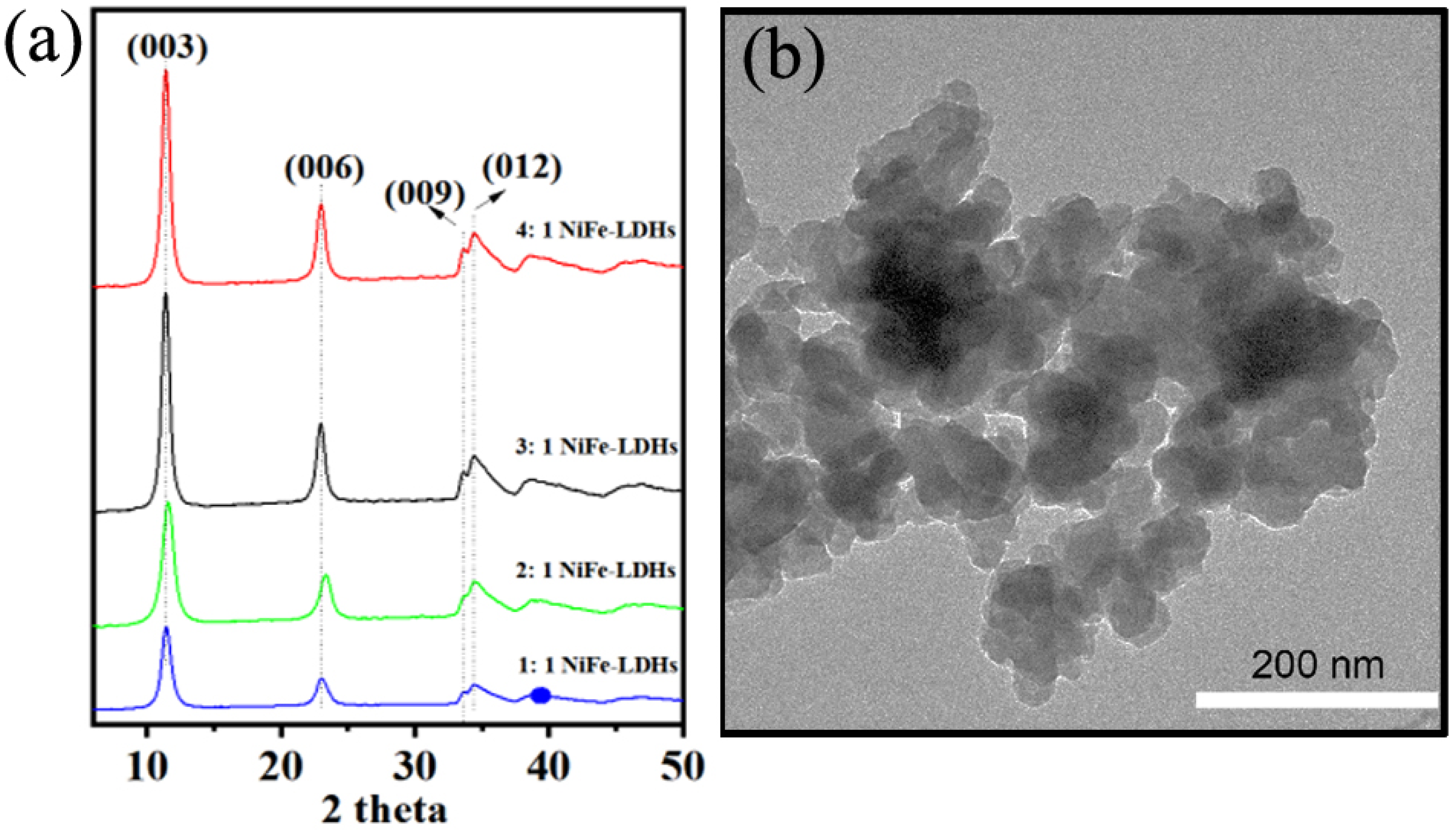
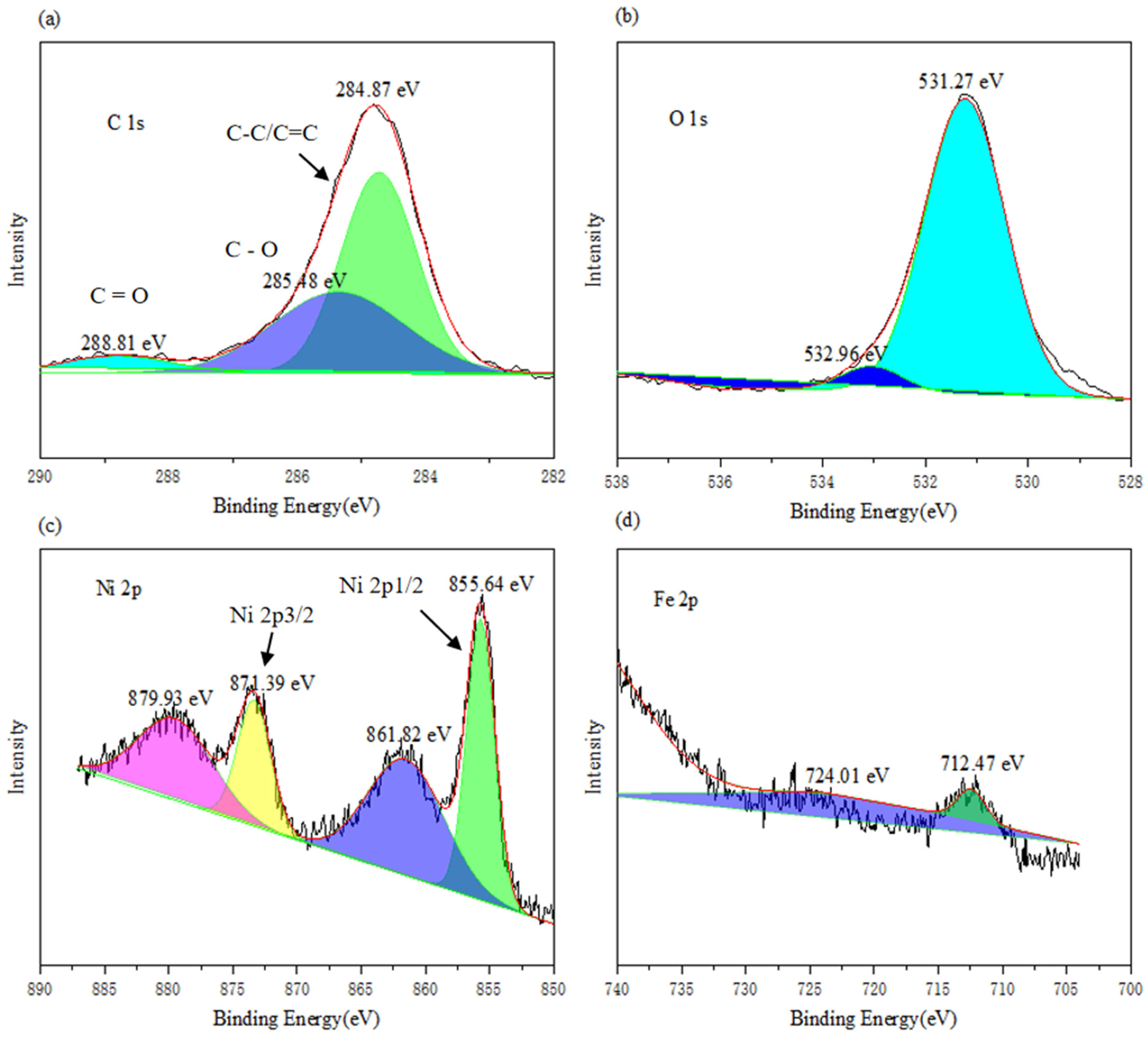

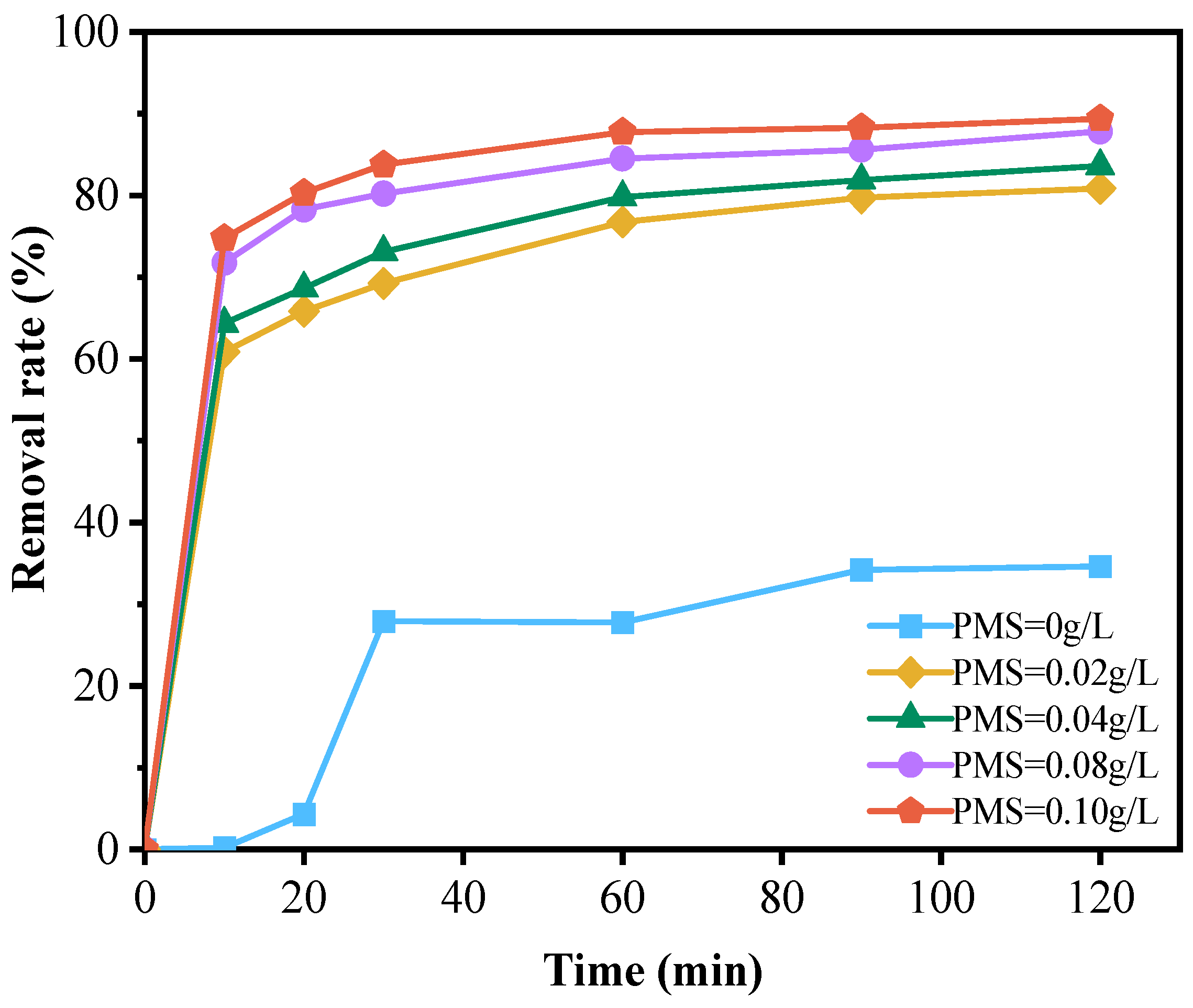

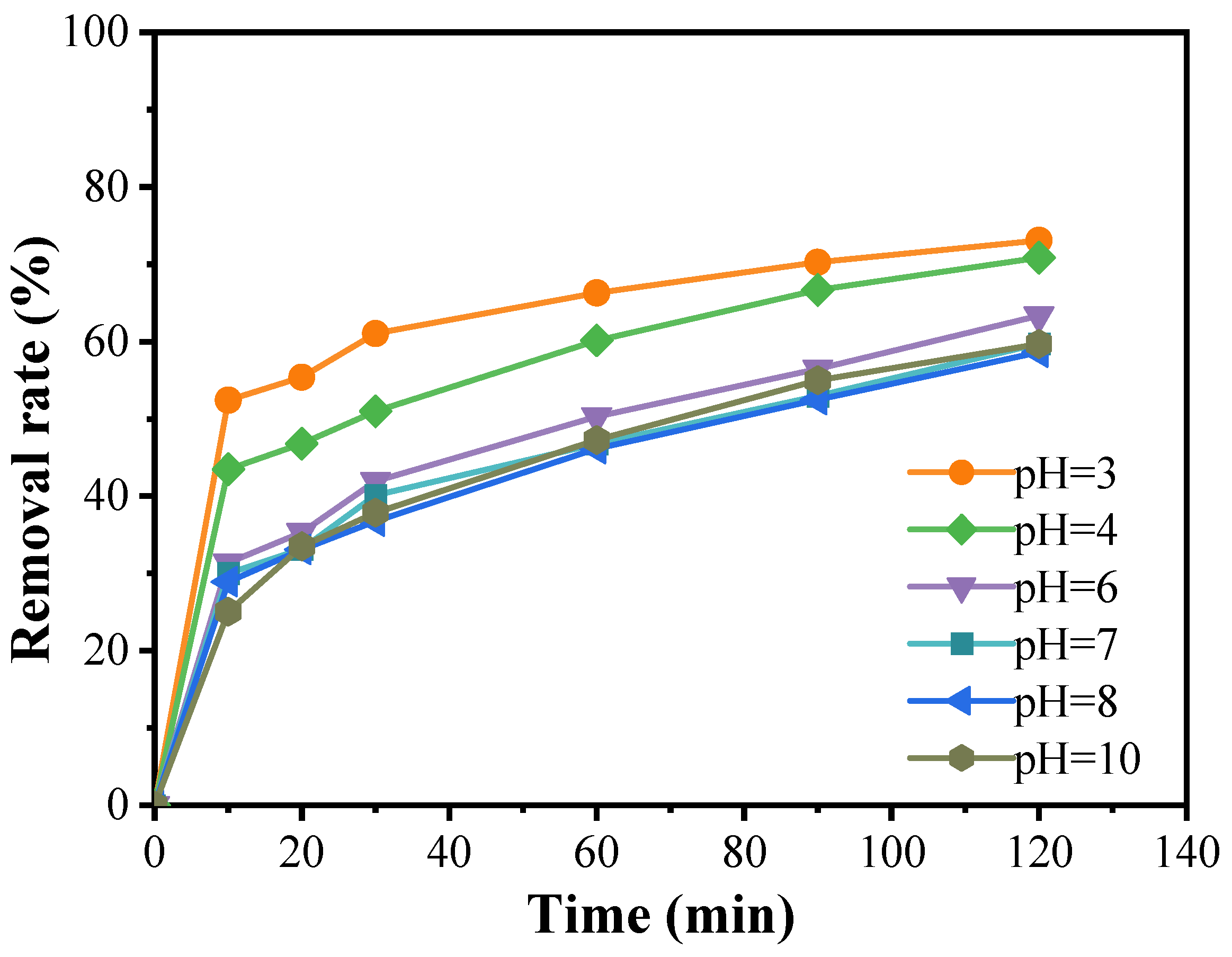
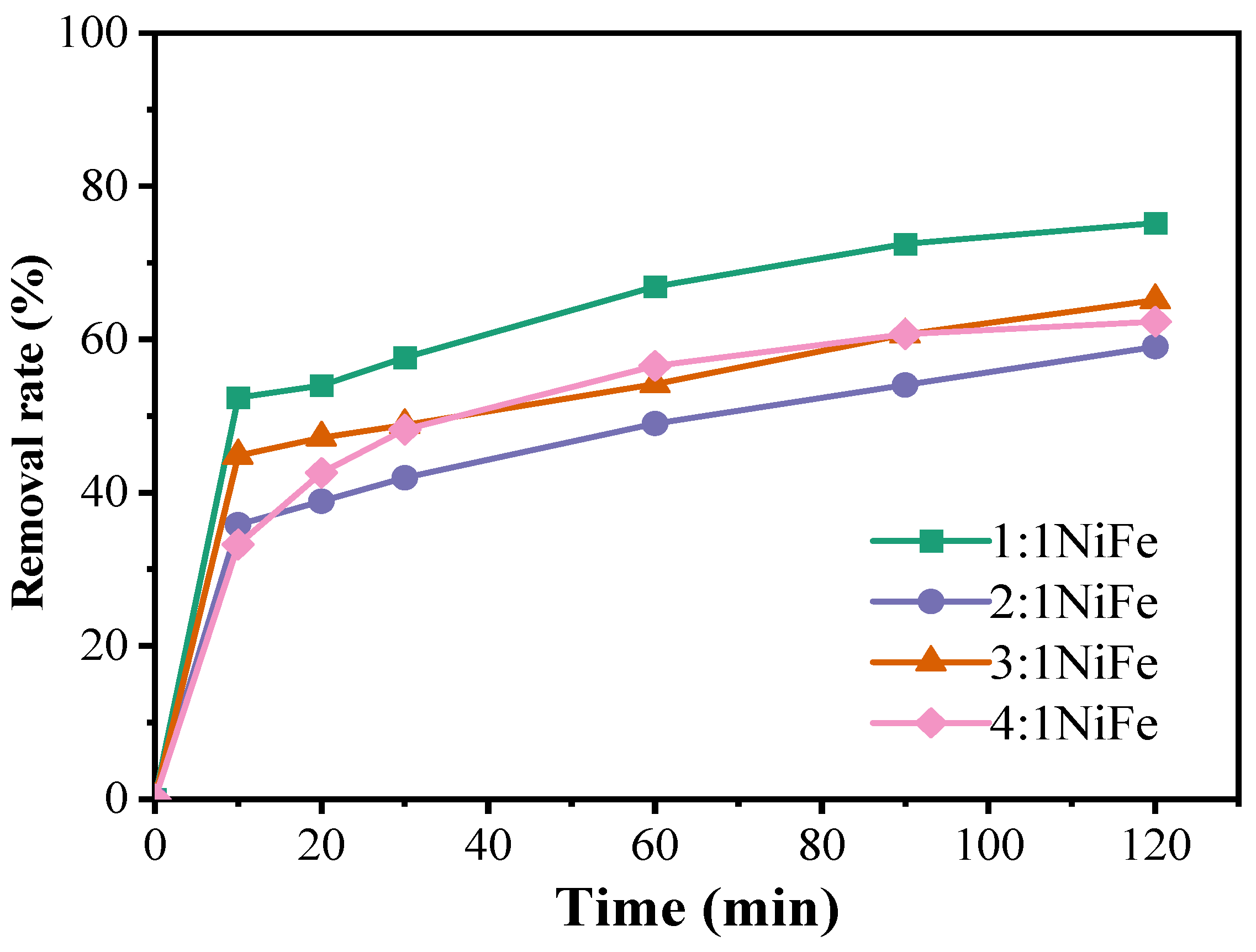
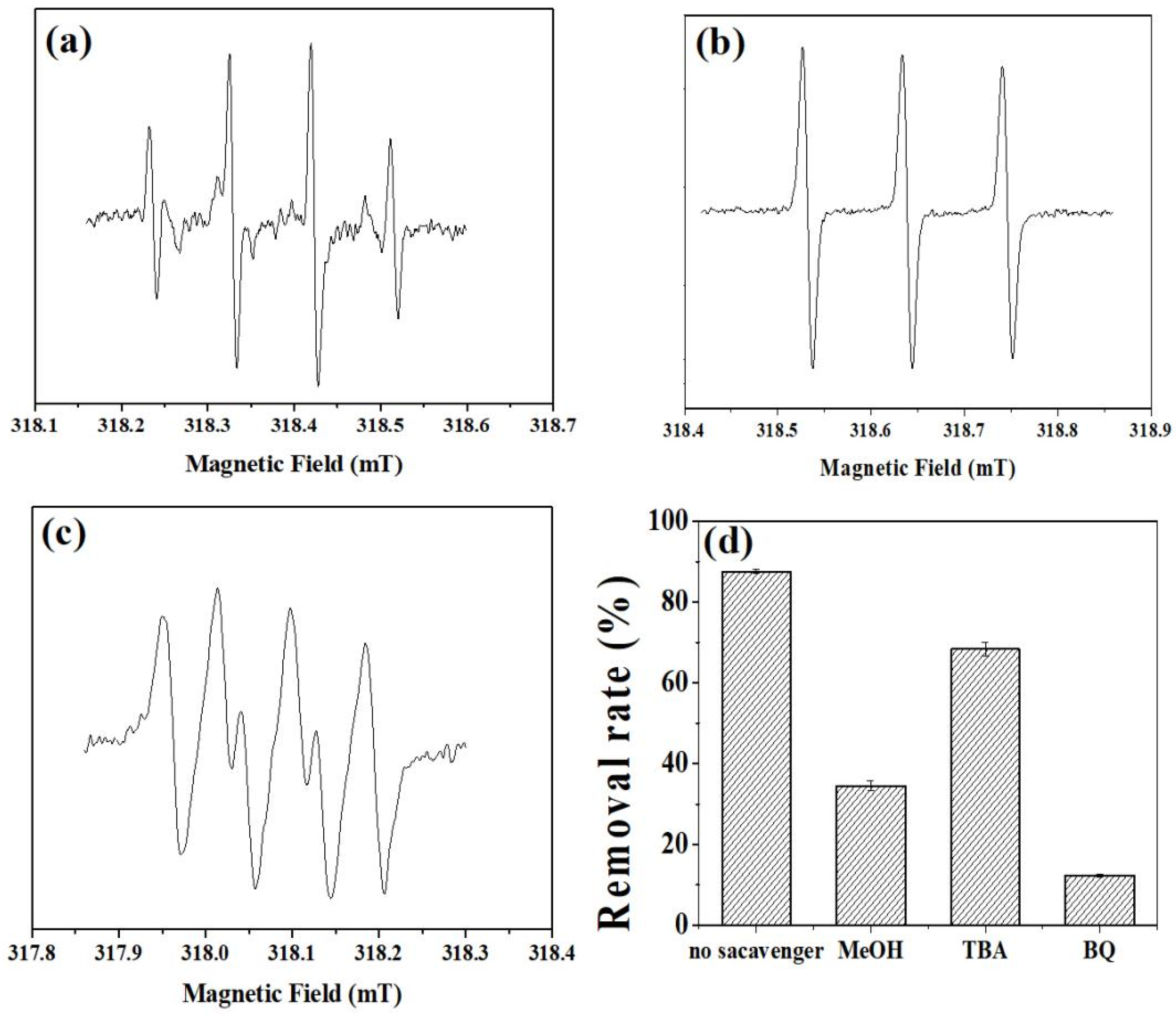

| Sample | BET Surface Area (m2 g−1) | Pore Volume (cm3 g−1) | Pore Size (nm) |
|---|---|---|---|
| 1: 1 NiFe-LDHs | 5.69 | 0.04 | 6.38 |
| 2: 1 NiFe-LDHs | 3.68 | 0.02 | 5.68 |
| 3: 1 NiFe-LDHs | 21.82 | 0.11 | 11.62 |
| 4: 1 NiFe-LDHs | 9.36 | 0.06 | 8.25 |
| Catalyst (Catalyst Dose) | PMS/PS | Pollutant Concentration | pH | Removal Efficiency |
|---|---|---|---|---|
| Mg-Fe-LDH@biochar (0.75 g/L) | 0.75 g/L (PMS, initial concentration) | Doxycycline, DOX (35 mg/L) | pH = 3–11 (optimum pH = 7) | Under the optimal conditions (catalyst dosage 0.75 g/L, PMS dosage 0.75 g/L, pH = 7.0), 88.76% doxycycline was removed within 120 min [38] |
| S-doped g-C3N4/biochar (0.25–1.2 g/L) | 0.5–3 mM (PS) | Tetracycline, TC (10 mg/L, initial concentration) | pH = 3–11 (As pH increased from 3 to 9, the degradation efficiency of TC increased from 76% to 91%) | Under the optimal conditions (SCNBC dosage 1.0 g/L, PS dosage 2 mM), the removal efficiency of TC was 81.7% [39] |
| ZIF-67@FDNW (0.2 g) | 50–650 mg/L (PMS) | Tetracycline hydrochloride, TCH (50 mg/L, initial concentration) | At pH 6 and 7, the degradation rate of TCH exceeds 95% | 94% (optimum condition) [40] |
| Silica-supported zero-valent iron, ZVI-Si (0.1–0.9 g/L, optimal dosage was 0.46 g/L) | 0.05–0.25 mM (PS, 0.22 mM, optimum concentration) | Tetracycline, TC (10–30 mg/L, optimum initial concentration was 10 mg/L) | pH = 2–9 (High degradation performance in pH 3–7) | 99.8% within 60 min (optimum condition) [41] |
| Cobalt-Doped Oxygen-Vacancies-Rich BiVO4 (0.2 g/L) | 0.1–0.7 mM (PMS) | Tetracycline, TC (20 mg/L, initial concentration) | pH = 5.2 (the catalyst demonstrates enhanced degradation efficiency) | 92.3% (Catalyst dose 0.2 g/L, PMS concentration 0.5 mM, within 10 min) [42] |
| Fc/CS@Fe3O4 (400 mg/L) | 400 mg/L (PMS, initial concentration) | Tetracycline, TC (30 mg/L, initial concentration) | pH = 3–11 (Acidic conditions (pH 3–5) are conducive to TC degradation) | 99.9% within 60 min [43] |
| S-scheme Bi2S3/doped gCN (0.2 g/L) | 1.5 g/L (PMS) | Tetracycline, TC (50 mg/L, initial concentration) | pH = 2–10 (pH = 6–7, the highest degradation efficiency) | 99.9% (Under 20 min of visible light) [44] |
| Iron modified sludge bio-hydrochar (IBHC, 0.05–0.4 g/L, optimal dosage was 0.2 g/L) | 1–10 mmol/L (PMS, optimal dosage was 5 mmol/L) | Tetracycline, TC (60 mg/L, initial concentration) | pH = 2–10 (pH = 4, the highest degradation efficiency) | 99.72% (optimum condition) [45] |
| Compound | Acute Toxicity (mg/L) | Chronic Toxicity (ChV, mg/L) | Log | Water | ||||
|---|---|---|---|---|---|---|---|---|
| Fish | Daphnid | Green Algae | Fish | Daphnid | Green Algae | Kow | Solubility | |
| (LC50, 96 h) | (LC50, 48 h) | (EC50, 96 h) | (ChV) | (ChV) | (ChV) | (mg/L) | ||
| DC | 7970 | 670 | 1100 | 1340 | 39.2 | 285 | −0.9988 | 2144.1 |
| DC 1 | 20,800 | 1620 | 3110 | 4460 | 87.7 | 758 | −1.6759 | 12,173 |
| DC 2 | 7560 | 630 | 1050 | 1310 | 36.5 | 271 | −1.0787 | 141,660 |
| DC 3 | 10,600 | 872 | 1510 | 1930 | 49.8 | 382 | −1.21 | 3979.1 |
| DC 4 | 7560 | 630 | 1050 | 1310 | 36.5 | 271 | −1.0787 | 141,660 |
| DC 5 | 2920 | 263 | 377 | 398 | 16.5 | 102 | −0.4016 | 25,132 |
| DC 6 | 596 | 121 | 49.2 | 49.7 | 9.85 | 70 | 0.3169 | 23,624 |
| DC 7 | 8.52 | 5.62 | 0.777 | 0.928 | 0.723 | 2.06 | 2.9289 | 687.71 |
| DC 8 | 83.7 | 47.8 | 36.4 | 8.23 | 4.73 | 9.63 | 2.0549 | 5990.2 |
| Very toxic | Toxic | Harmful | Harmless | |||||
Disclaimer/Publisher’s Note: The statements, opinions and data contained in all publications are solely those of the individual author(s) and contributor(s) and not of MDPI and/or the editor(s). MDPI and/or the editor(s) disclaim responsibility for any injury to people or property resulting from any ideas, methods, instructions or products referred to in the content. |
© 2024 by the authors. Licensee MDPI, Basel, Switzerland. This article is an open access article distributed under the terms and conditions of the Creative Commons Attribution (CC BY) license (https://creativecommons.org/licenses/by/4.0/).
Share and Cite
Chen, J.; Tang, X.; Wang, J.; Bi, S.; Lin, Y.; Huang, Z. Activation of Persulfate by NiFe-Layered Double Hydroxides Toward Efficient Degradation of Doxycycline in Water. Catalysts 2024, 14, 782. https://doi.org/10.3390/catal14110782
Chen J, Tang X, Wang J, Bi S, Lin Y, Huang Z. Activation of Persulfate by NiFe-Layered Double Hydroxides Toward Efficient Degradation of Doxycycline in Water. Catalysts. 2024; 14(11):782. https://doi.org/10.3390/catal14110782
Chicago/Turabian StyleChen, Jie, Xiaojun Tang, Jing Wang, Shiming Bi, Yinhan Lin, and Zhujian Huang. 2024. "Activation of Persulfate by NiFe-Layered Double Hydroxides Toward Efficient Degradation of Doxycycline in Water" Catalysts 14, no. 11: 782. https://doi.org/10.3390/catal14110782
APA StyleChen, J., Tang, X., Wang, J., Bi, S., Lin, Y., & Huang, Z. (2024). Activation of Persulfate by NiFe-Layered Double Hydroxides Toward Efficient Degradation of Doxycycline in Water. Catalysts, 14(11), 782. https://doi.org/10.3390/catal14110782







